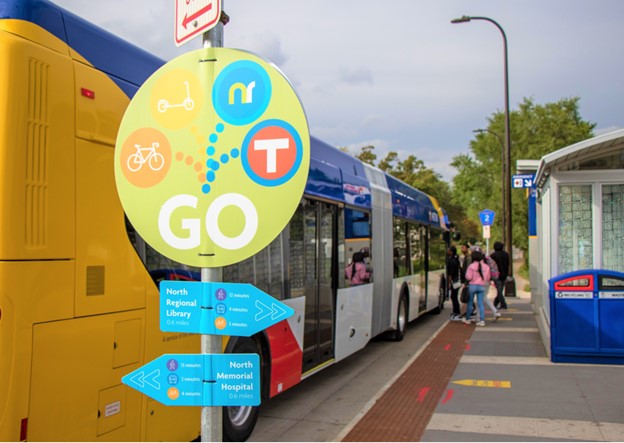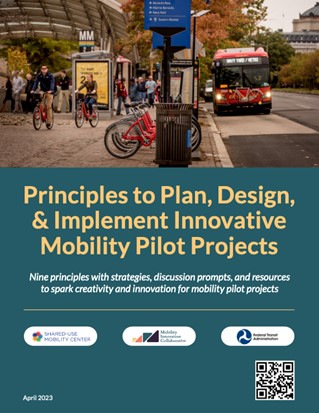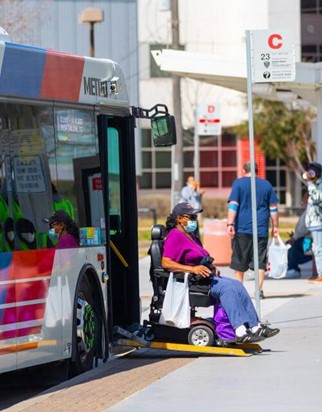Guest Blogger—Alvaro Villagran is director of federal programs for the Shared-Use Mobility Center (SUMC). The Shared-Use Mobility Center (SUMC) is a public-interest organization and an international thought leader in shared mobility. SUMC is working to replace car-centric transportation with people-focused shared mobility to fight climate change, promote equity and universal access, and strengthen community.
Since 2016 the Shared-Use Mobility Center (SUMC) has partnered with the Federal Transit Administration (FTA) to support more than 60 mobility innovation projects from around the country. Emerging from this partnership, the Mobility Innovation Collaborative (MIC) program was created with the goal of advancing mobility innovation and supporting transportation systems that work for everyone. Through the MIC program, SUMC provides technical assistance, facilitates project development tools, and captures stories and lessons learned from more than 40 public agencies piloting innovative mobility projects.

Credit: City of Minneapolis
Over the course of SUMC’s work with the MIC program, we have observed various challenges and opportunities that practitioners face when designing mobility pilot projects. Through conversations with innovators, we recognized that a resource designed to help guide the innovative process before and during the start of a mobility pilot project would be helpful to those involved in planning and implementing these projects.
Using information gathered through the MIC program as well as surveys, workshops, and expert interviews with mobility innovators, SUMC developed a guidebook entitled “Principles to Plan, Design, & Implement Innovative Mobility Pilot Projects.”[1] This guidebook contains a list of nine principles, each with strategies, real-world examples, resources, checklists, and discussion prompts to help spark creativity for mobility pilot projects. The guidebook is a tool to improve the process and outcomes of transportation pilot projects, and our hope is that it will help innovators in the transportation sector better plan, execute, and learn from their mobility pilot projects.
The Nine Principles
The nine principles discussed in the guidebook are listed below.
- Define end users’ needs, wants, and pain points before brainstorming a pilot project.
- Reflect on whether technology is desired or required.
- Build a strong, functional, and creative team with the skill sets to implement and iterate pilot projects.
- Foster partnerships to pursue and sustain new mobility projects.
- Establish thorough data agreements to avoid disputes.
- Connect with innovators that were involved in similar mobility pilots.
- Leverage existing resources effectively.
- Be creative with testing the pilot to get feedback and iterate quickly before full-scale implementation.
- Build flexibility into the pilot’s project approach to better navigate uncertainties.

Credit: Shared-Use Mobility Center
While we believe each principle is important for any mobility pilot, the principles particularly relevant to developing universally designed and accessible transportation for persons with disabilities, caregivers, older adults, and marginalized populations are described in more detail here.
Define end users’ needs, wants, and pain points before brainstorming a pilot project.
To define your end user’s pain points, it is crucial that you understand who your end users are. This is an important opportunity to ensure that older adults, persons with disabilities, caregivers, and marginalized populations are included in engagement strategies to better understand their mobility goals, frustrations, and how your mobility project can be designed to consider and include solutions to their pain points.
Reflect on whether technology is desired or required.
Technological advancements have the potential to improve many different aspects of the mobility landscape, but new technologies can bring unexpected downsides as well: They may be expensive to implement or maintain, incompatible with existing systems, or raise concerns over data sharing and privacy. Perhaps most importantly, with new technology comes concerns over whether these advancements will disproportionately benefit certain groups over others. For example, older adults and people with disabilities have unique transportation needs and are too often left out of the conversation, so it is important to consider how new services will impact them. Excitement for technological advancements is natural, but some people can get left behind in that excitement. Therefore, before piloting a new product or service, agencies need to carefully consider the realities of how all users perceive, use, and access transportation services.
Establish thorough data agreements to avoid disputes.
Agencies must understand and clarify their data needs before establishing data agreements with vendors. This ensures that the processes to measure a pilot’s performance, make necessary improvements, meet user needs, and gain new insights are explicit and direct. When you are designing a mobility pilot project with older adults or people with disabilities in mind, recognize that you may have slightly different data needs and additional performance metrics you may want to track that you might not have for other projects. Those considerations should be fully conveyed to your project partners and reflected clearly in your agreements so that all project partners are on the same page.
Be creative with testing the pilot to get feedback and iterate quickly before full-scale implementation.

Credit: Houston METRO
Although pilot projects are by nature temporary steps toward larger-scale projects, they can still be costly and time consuming. It is, therefore, important to be able to test and evaluate a pilot project before and during its implementation to make the most out of it. Having strategies to collect feedback, learn from failures, and iterate during a pilot project are necessary to make your pilot successful. This is particularly salient for projects involving older adults and people with disabilities. The ability to iterate quickly means you can incorporate real feedback from people most impacted by your project and make sure it works for them.
Conclusion
Innovative mobility pilots present opportunities to take a fresh look at transportation systems, processes, and infrastructure, and figure out how to make them work best for everyone. SUMC supports and applauds mobility pilot projects that follow universal design principles and are developed with all users in mind. We hope this guidebook will be an inspiration to you and a support to your work.
You can learn more about the “Principles to Plan, Design, & Implement Innovative Mobility Pilot Projects,” and download a copy of the guidebook at the Mobility Learning Center.
[1] The Mobility Innovation Guidebook was written by SUMC staff members Alex Rosander, Hani Shamat, Manali Sheth, and Alvaro Villagran as an initiative of the Mobility Innovation Collaborative (MIC), a program funded by the Federal Transit Administration.
Leave a Reply